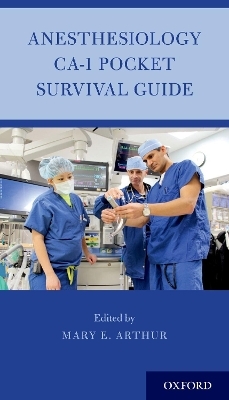
Anesthesiology CA-1 Pocket Survival Guide
Oxford University Press (Verlag)
978-0-19-088588-5 (ISBN)
operating room within the first few months.
Anesthesiology CA-1 Pocket Survival Guide will flatten the learning curve and improve the comfort level of trainees entering the OR for the first time. Intended to help provide a smooth transition from intern to resident anesthesiologist, it highlights information to seek out during the orientation period. It provides easy-to-follow instructions for such common tasks as preparing the anesthesia machine, positioning the patient, and entering information into the electronic management
system (EMS) and suggests how to obtain and organize a patient's preoperative information to present to the attending anesthesiologist.
Mary E. Arthur MD FASE is an associate professor of anesthesiology with joint appointment with the department of surgery and a residency program director at the Medical College of Georgia at Augusta University, whose academic career focus is on teaching. She has more than 15 years of experience as an anesthesiologist, has won several resident teaching awards and published in many journals. Dr. Arthur's passion is to provide an optimal learning experience for anesthesiology residents to make a successful transition from internship to clinical anesthesia, providing them with the foundation for lifelong learning and personal development in passing the ABA basic examination.
1. What to Expect
Sanjay Dwarakanath and Lindsey Van Drunen
1.1 Orientation/Boot camp
1.2 Mentor/Preceptor program
1.3 Preop discussion with attending the day before
1.4 Anesthesia Knowledge Testing (AKT)
1.5 Working in multi-disciplinary teams
2. Making the most of your CA-1 year
Mary E. Arthur and Vaibhav Bora
2.1 Do's and Don'ts
2.2 Speaking up
2.3 Professionalism
2.4 Interpersonal and communication skills
2.5 Work-life balance
2.6 Burnout and reaching out
2.7 Examinations
3. Pre-anesthesia Patient Evaluation
Efrain Riveros-Perez and Mauricio Perilla
3.1. Pre-Admission Testing
3.1.1 Evaluating the patient
3.1.1.1 Preanesthesia screening
3.1.1.2 Physical status/co-morbidity awareness
3.1.1.3 Medication reconciliation
3.1.1.4 Risk stratification
3.1.1.5 Preop testing
3.1.1.6 Informed consent
3.1.1.7 Patient instructions
3.1.1.8 Documentation of evaluation
3.1.2 Communicating the evaluation
3.2 Pre-anesthesia evaluation in special circumstances
3.2.1 Acute care setting
3.2.2 Obstetrics
3.2.3 Cardiac evaluation for non-cardiac procedures
3.2.4 Patients with end stage liver disease
4. Anesthesia Care on the Day of Surgery
Claudia F. Clavijo, Mary E. Arthur, and Efrain Riveros-Perez
4.1. Documentation
4.1.1. Informed Consent
4.1.2. Phases of care assessment/evaluation
4.1.2.1. Final discussion of plan, completion of day of physical exam and documentation update
4.1.3. Handwritten requirements
4.1.4. Anesthesia information management systems
4.2. Operating room anesthesia set-up and considerations
4.2.1. Equipment/ Standard Monitors and Safety Check
4.2.2. Patient safety considerations
4.3. Anesthesia pharmacology basics
4.4. Prepping the patient
4.4.1. Pharmacologic considerations
4.4.2. Airway considerations
4.4.3. Monitoring considerations
4.4.4. Ventilation considerations
4.4.5. Positioning considerations
4.4.6. Positioning complications
4.4.6.1. Peripheral neuropathy
4.4.6.2. Upper extremity injuries
4.4.6.2.1. Ulnar nerve
4.4.6.2.2. Brachial plexus injury
4.4.6.3. Lower extremity injuries
4.4.6.3.1. Common peroneal nerve injury
4.4.6.3.2. Sciatic nerve
4.4.6.3.3. Femoral nerve
4.4.6.3.4. Saphenous nerve
4.4.6.3.5. Anterior tibila
4.4.6.3.6. Obturator
4.4.7. Eye Injury
5. Fundamentals of Anesthesia Care
Claudia F. Clavijo and Efrain Riveros-Perez
5.1. Anesthesia care basics
5.1.1. Surgical time out
5.1.2. Induction
5.1.3. Maintenance
5.1.4. Emergence
5.2. Patient Management
5.2.1. Regional block for acute pain management
5.2.2. Intraoperative Awareness
5.2.3. Difficult Airway Algorithm
5.2.4. Fluid Management
5.2.5. Transfusion Therapy
5.2.6. Hypoxemia
5.2.7. Electrolyte Abnormalities
5.2.8. PONV prevention
5.2.9. Extubation Criteria and Delayed Emergence
5.2.10. Rational Opioid Use
5.2.11. Intra-operative Hypotension and Hypertension
6. Crisis management in the Perioperative Setting
Claudia F. Clavijo and Ronnie Zeidan
6.1.1. Laryngospasm and Aspiration
6.1.1.1. Laryngospasm
6.1.1.2. Perioperative pulmonary aspiration
6.1.2. Oxygen failure in the OR
6.1.3. Anaphylaxis
6.1.4. Local Anesthetic Toxicity
6.1.5. Malignant Hyperthermia
6.1.6. ACLS in the OR setting
6.1.7. Perioperative Antibiotics
6.1.8. Operating room fires
7. Post-anesthesia Care on the Day of Anesthesia
Lindsey Van Drunen and Sanjay Dwarakanath
7.1. Safe patient transport
7.2. Hand-off reporting to next level of care
7.2.1. Critical Care Handoff
7.2.2. Post-Anesthesia Care Unit Phase I
7.2.3. Fast-track to Phase II Post Anesthesia Care Unit
7.3. Post-anesthesia care unit discharge
7.4. Post-anesthesia evaluation
7.4.1. In PACU
7.4.2. On nursing unit
7.4.3. By phone
7.4.4. Considerations of care
7.5. Post-anesthesia patient instructions for ambulatory patients
8. Specialty practice situations
Efrain Riveros-Perez and Mauricio Perilla
8.1. Anesthesia in remote locations
8.1.1. Endoscopy
8.1.2. Eye room
8.1.3. EP Lab
8.1.4. Cath Lab
8.1.5. Radiology suite
8.2. Emergency airway procedures/intubations
9. Continuous Quality Improvement
Sarah M. I. Cartwright
9.1. Terminology
9.1.1. Quality
9.1.2. Continuous Quality Improvement
9.2. Structured methodology and tools
9.2.1. Lean
9.2.2. Six sigma
9.3. Quality improvement tools
9.3.1. Outcome measures
9.3.2. Project charter
9.3.3. Voice of the Customer Translation Matrix
9.3.4. SIPOC Matrix
9.3.5. Data collection plan
9.3.6. Fishbone diagram
9.4. Resources
10. Glossary
Nadine Odo, Augusta University
| Erscheinungsdatum | 07.10.2018 |
|---|---|
| Verlagsort | Oxford |
| Sprache | englisch |
| Themenwelt | Medizin / Pharmazie ► Medizinische Fachgebiete ► Anästhesie |
| ISBN-10 | 0-19-088588-2 / 0190885882 |
| ISBN-13 | 978-0-19-088588-5 / 9780190885885 |
| Zustand | Neuware |
| Haben Sie eine Frage zum Produkt? |
aus dem Bereich


